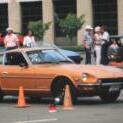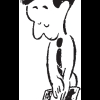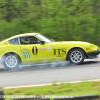A while ago, I was looking into an issue where my idle would hang a little because the throttle body butterfly would not always return to fully closed. The puzzling part is that it always closed just fine with the engine off and it only got sticky when manifold vacuum was present with the engine running. Reference old thread about it, but that old thread never really got to the bottom of it: http://www.classiczcars.com/topic/45152-sticky-throttle-body-hanging-idle/#comment-409180
My solution at the time was to simply add an extra turn to the throttle body return spring and that extra spring force overcame whatever was causing the stick. Worked, but not really the right way to fix it and I always wanted something better. So this off-season, I pulled the throttle body off again to do some more investigation.
I believe I have traced the sticking issue to worn through chrome plating on the throttle shaft exposing the softer steel beneath, and that softer steel doesn't slide as well against the pressed in bushings pressed of the throttle body. Even though everything seems to move just fine with the engine off, I believe the friction between the worn shaft and the bushings is amplified when the two of them are forced together by manifold vacuum causing the hanging idle.
After considering several different approaches to fixing the issye, I decided to try replacing the original steel throttle body bushings with Delrin. The thinking was that Delrin is a naturally slippery material and the hope is that it won't stick to the exposed steel of the shaft.
Also, while I was in there, something else I wanted to improve is that with the original design - The only thing locating the throttle butterfly plate within the throttle body bore is the butterfly plate itself (just like the carbs). In other words, when the throttle is closed, the butterfly plate should self center within the throat because the walls of the throttle body bore will contact the brass butterfly and move it into the center. But when the butterfly is opened, the plate is free to move back and forth a little within the bore. This results in scraping against the internal walls and wear on the walls and butterfly. I was thinking that I might be able to come up with a way to incorporate shaft locating into a new bushing design.
So with all that as background... I started with this:
I ran a tap into the original bushings and pulled them out:
Here's the original steel bushing and the new Delrin bushing for the side where the throttle linkage attaches. The larger diameter lip section keeps the throttle butterfly from moving too far in one direction:
Here's the linkage side in place. You can see how the lip is sandwiched between the linkage and the body casting to take up the side-to-side slop and acting as a thrust washer in the inward direction. The other end will address the play from the TPS direction, but this is half the battle won:
And here's the concept I came up with for the TPS side. I turned a groove on the throttle shaft to accept a spring clip, and made a stainless steel "D" holed thrust washer to run against the outside of the bushing. These features are what prevent the throttle shaft from moving in from this direction. With the combination of the two limiting features, the throttle plate is now locked centered in the middle of the throttle body throat bore. This side was more of a PITA because there is very little room to work with since everything has to be hidden behind the TPS:
This is what the TPS side looks like when installed. Spring clip limits motion in the inward direction:
Here's the two new bushings on the throttle shaft to show how they work:
A little epoxy to keep the bushings from spinning in the throttle body casting (that's what the grooves are for). Not much sticks to Delrin (including epoxy), but it doesn't need to stick well. Just enough to make sure the shaft spins withing the bushing instead of the bushing spinning within the body:
And a little blue thread lock on the butterfly screws:
It's all put back together and back on the car and I'll post the final results after the salt is off the roads!











